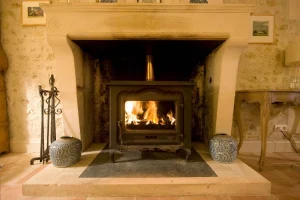Updated on March 12, 2023
In the modern day, wood-burning stoves have become more efficient than before. When compared to older stoves, the latest Ecodesign wood burners may achieve efficiency levels of around 90%, which is incredible.
You want to ensure that you’re getting the maximum heat out of your wood burner in order to take advantage of rising heating costs.
You can use this tutorial if your wood-burning stove isn’t producing enough heat, or if you just want to get ready for the upcoming cold season.
How Do I Get the Most out Of My Wood Burning Stove
To get the most out of the heat generated by a wood burning stove, many homeowners turn to the usage of a stove fan. Instead of allowing hot air to just ascend to the ceiling, these simply attach to your stove pipe and circulate it throughout the room.

Are You Getting the Best Heat From Your Stove?
If you haven’t purchased your stove yet or are considering doing so, be sure it has the appropriate heat output.
In this guide, you will learn why this is not a smart idea if you choose one that is too powerful.
How Do You Use a Log Burner Tip
1. Have the Flue Cleaned as And when Required
You should have your chimney or flue cleaned at least once a year, according to the Chimney Safety Institute of America (CSIA). The National Fire Protection Association (NFPA) recommends this.
You’ll need a flue in order to get the air from the stove and out of your house, which in turn helps to feed the fire by sucking air into the stove. Your stove’s output will be reduced if the vent is clogged.
If your wood stove’s flue is clogged or obstructed by tar or debris that has fallen down, you may not be able to get the maximum amount of heat out of your appliance. A clogged flue can also cause smoke to enter the room when the door is opened, preventing it from exiting your property in an efficient manner.
If you often use your stove, you should have your flue swept more frequently than once a year. Flue blockage can occur more frequently if you utilise softwoods instead of hardwoods during burning.
Flue and chimney cleaning is a vital part of maintaining a safe and efficient home.
2. Bring Wood Inside Before Each Fire
Using cold wood in your stove might be difficult since it takes longer for the logs to heat up to an appropriate temperature for the combustion process to begin.
Because we keep our wood outside, we like to bring it in the day before we plan to burn it in the stove. For our stove fires, the wood must be warmed to room temperature before it can be utilised.
This makes it easier for new logs to ignite in the stove and prevents the existing fire from struggling and reducing heat production.
Suitable wood stove temperatures
Wood burning stoves operate best around 260-460°C temperatures for maximum heat output. Your fire will burn too slowly to produce much heat if you set the temperature any lower than this. Don’t believe that you can extend the life of your gasoline by burning it more slowly.

